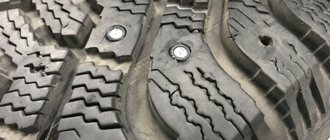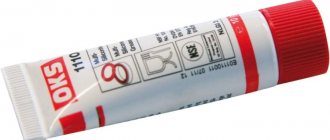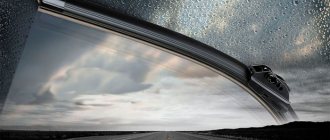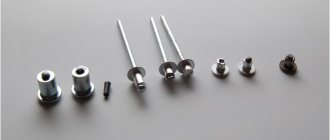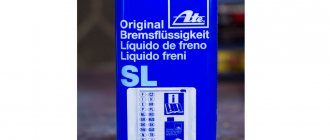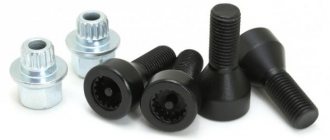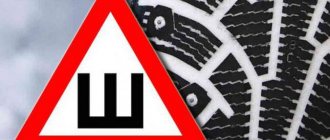Winter is getting closer, frosts have already begun in full force in many Russian cities, and many car owners have managed to change the shoes of their cars. Others are in no hurry to do this - according to the technical regulations of the Customs Union, summer tires cannot be used only in three winter months, and studded tires, accordingly, cannot be used in the summer.
And yet a reasonable question arises - when do you really need to change tires? But you still need to choose between studded tires (which can no longer be used without the appropriate sign), so-called “Velcro” - friction tires, and all-season tires. Experienced car owners have long had their own opinions on all these issues, but it’s easy for newbies to get confused behind the wheel. So Nation News turned to auto expert and road accident expert Yuri Antipov, and he explained why this or that type of winter tires is good, and when you need to change to them.
As for the timing of replacement, everything is more or less clear: when the temperature drops below five degrees, it’s time to “change your shoes,” and if the thermometer drops below zero, then you definitely can’t put it off, the specialist emphasized. With the choice of tires the situation is somewhat more complicated.
Velcro
Friction rubber or simply Velcro are tires that do not harden in the cold like summer tires. This type of tire is softer and should not be driven in the summer, as this very softness will cause it to wear out faster. In winter, it retains its properties in cold temperatures down to minus 20 degrees and performs well on dry but frozen asphalt. But as soon as she gets on ice, problems begin.
“As soon as it gets on ice, where the road is covered with snow, or even worse - ice, these tires begin to slide, just like regular summer tires. In this case, the only option is studded tires,” said Yuri Antipov.
Comparative characteristics
So, which is better - the first type of tires or the second? Here, a lot depends not only on climatic conditions, but also on the intensity and mode of operation of the vehicle. If the driver primarily plans to travel around a large metropolis to work and back, then friction tires will be an excellent choice for him. For those who, due to duty or hobbies, often travel to country roads in winter or live in a small town, where, as a rule, the cleaning of roads and especially courtyards is, to put it mildly, not very good, it is better to opt for the usual studded tires. It behaves worse in city conditions, but it has no equal in poorly cleaned country areas.
Let's evaluate a number of comparative characteristics that became known after the corresponding test was carried out, the task of which was to establish which tires are preferable:
- studded tires are characterized by low efficiency during acceleration and braking on traditional asphalt;
- because of the spikes, the vehicle's controllability is reduced;
- they are a source of constant noise while driving.
Spikes
Studded tires are best suited for driving on snowy or icy roads. However, such tires make more noise, and as soon as they get on a dry or, especially, a wet road, the advantages turn into disadvantages, and the braking distance of the car only increases. This also applies to streets treated with chemicals. In addition, now in Russia, when using studded tires, you need to hang a sign with the letter “SH” on your car.
You also need to consider whether you are going to travel abroad by car. So, residents of St. Petersburg who are going to Finland should remember that studded tires can be used there from November 1 to March 31, or if this is necessary due to the weather. And in some European countries, spikes are generally prohibited: in Poland, Romania, the Czech Republic, Slovakia, Hungary, Bulgaria, Serbia, Macedonia, Croatia, Slovenia, Bosnia and Herzegovina, Montenegro, as well as in Germany, the Netherlands and Portugal. It is also banned in Turkey.
Yuri Antipov himself uses studded tires, as he often travels to the Moscow region and other regions. In general, when choosing tires, you need to take into account the individual conditions of the city where you live and how local utility workers approach the fight against ice. For example, in Moscow the streets are treated with chemicals and there is no ice on them.
“Each city has its own conditions. There is no ice on the streets in Moscow. The roads are watered with reagents, so the road is either dry or becomes wet after snow. In such conditions, Velcro is quite acceptable if you only ride in the city. On studded tires in such conditions, the braking distance only increases. In many other cities, the roads are only covered with sand, they remain snow-covered, and spikes here are the only option,” the expert said.
Studded tires.
Advantages of studded tires.
Tires of this type are recommended for residents of roads that require increased cross-country ability, that is, those who live in the suburbs or countryside. Let me explain why. The fact is that roads outside cities are characterized by a large number of bends and turns, icy conditions or the fact that they are covered with loose snow. Therefore, it is on them that the car enthusiast will be able to appreciate the advantages of studded tires compared to Velcro. Firstly, studded tires have a short braking distance and rapid development of speed on an icy road; this is the most important advantage of studded tires compared to Velcro, but not the only one. Secondly, excellent grip on the road (described above). Thirdly, excellent road stability. Fourthly, the absence of skidding on turns, which are strewn with country roads. And if a thaw comes and the ice begins to melt, then you certainly cannot do without spikes on such a road.
Disadvantages of studded tires.
Now about its disadvantages: high noise level; increased fuel consumption; when the frost is more than 35 degrees, the spikes become a useless attribute, because even they will not be able to take the hard ice that forms on the road at this temperature. Of course, the “habit” of thorns falling out from time to time cannot be considered an advantage. Well, there is one more drawback that I discovered - the absolute uselessness of studded tires on a clean and wet road surface. Moreover, when using studs on such a surface, the car’s handling deteriorates, its braking distance increases, and the tires wear out quickly.
All-season tires
The expert spoke negatively about the “all-season” vehicle beloved by many. This is a “neither fish nor fowl” option - such tires simply do not provide maximum comfort and safety in any season, and in the summer they also lead to increased fuel consumption.
“All-season tires are a universal option. You can use it both in winter and in summer. But you will not get the maximum effect from braking and from operating the car in general. In summer there will be increased fuel consumption, and in winter there will be insufficient traction. And when extreme conditions or some kind of force majeure begin, and you want to get maximum confidence, all-season tires will not justify themselves,” Antipov explained.
Which winter tires are best?
Traditionally, when choosing winter tires, motorists give preference to so-called “Velcro” or studded tires. Both the first and second types of tires have their own advantageous features and certain disadvantages.
Studded tires are fairly hard tires, the tread of which contains a large number of metal spikes protruding from the base by 1-2 millimeters. They provide good grip even on heavily snowy road surfaces and allow you to get out of deep snowdrifts.
Spikes
Velcro is a non-studded rubber that has a special tread with a large number of grooves. Thanks to this, such tires have the ability to absorb moisture that forms on the road surface and seem to stick to the track while the car is moving. In addition, the effect of tire adhesion to the road surface is enhanced by the presence of numerous grooves along which excess water accumulations are drained. It is for this characteristic feature that this rubber began to be called “Velcro.”
Drive car
In addition to the type of tire, the vehicle's drive also affects the behavior of the car in winter. As Yuri Antipov explained, front-wheel drive cars perform best in winter. However, this, of course, also depends on the driver’s skills.
“In principle, cars with front-wheel drive behave more stable in winter, but some specifics must be taken into account. If you let off the gas on a front-wheel drive car while it is skidding, it will skid even more. Here the opposite reaction occurs: you were afraid of the initial skid, you let off the gas and the front-wheel drive spun you even more. If you adequately feel the skid, but do not take your foot off the gas pedal, then the front-wheel drive car will behave more stable,” concluded Yuri Antipov.
Pros and cons of velcro tires on front-wheel drive
Velcro now differs fundamentally from studs only in the absence of these same spikes. Sometimes wheels of different types (spike and Velcro) have a similar pattern, so it is now impossible to talk about any uniqueness of the Velcro tread.
Velcro tire © Toronto Star
Pros of Velcro
- Grip on clean asphalt. On a clean, flat road, Velcro have maximum contact with the surface, as if sticking to it, which is why they got their nickname. In urban conditions, such tires behave in winter like summer tires in the warm season.
- Life time. In the city, on cleared asphalt, Velcro tires wear out less, since they do not have hard elements in the form of studs, in addition to the tendency to get lost, which also destroy the rubber at the landing site.
- Behavior in wet snow . Moving through wet snow of small thickness, the Velcro presses its way, creating an imprint of its tread on it. On front-wheel drive, this effect is enhanced by the constant load on the wheels.
- Silence. No thorns - no noise made by them on hard surfaces. Driving comfort is comparable to that on summer tires.
Disadvantages of Velcro
- Behavior on ice. A road covered with an ice crust is easily “lost”; the grip disappears, since the wheels do not have enough hard inclusions that improve contact with the ice. In a high-speed skid, applying the throttle may not help: the wheels will spin, and the car will continue to go sideways, since there is nothing to catch on the ice.
- Braking distance on snow and ice . Velcro rubber tends to slide and skid during braking; the absence of additional friction points in the form of spikes increases the braking distance.
- Worst start on slippery roads. When starting off on a slippery surface, the risk that wheels without studs will slip is higher. Velcro simply has nothing to grind the ice layer to gnaw through to the asphalt.
Studs vs Velcro for front-wheel drive © Winnipeg Free Press Autos
After analyzing the pros and cons, we can come to the conclusion that tires with studs on a front-wheel drive car perform better on snowy and icy roads. On a clean track, even a frozen one, Velcro has more advantages.
Spikes are needed in the conditions of the northern regions, as well as when driving on country roads and lightly loaded roads, which are often not cleaned in a timely manner. In a metropolis, where roads are quickly cleared and watered with reagents, the need for spikes is minimal. The same goes for busy intercity highways, where snow and ice almost never linger.
Modern control and safety systems, such as ABS, stabilization, and skid protection, allow you to comfortably use a car with front-wheel drive in the city, without studs. They become useless and sometimes even harmful. This is why (and not because of the accelerated wear of asphalt) tires on studs are prohibited in some EU countries.
Cooper Weather-Master WSC
Universal winter tires for all-wheel drive crossovers and SUVs. This model has a directional tread pattern and an innovative rubber compound. The manufacturer claims that this is an excellent choice for the city. The tire self-cleans well and has productive traction on icy and wet roads. The tread has 132 holes for studs, which can be inserted if desired.
Having studied customer reviews, you can see that the tires demonstrate excellent grip on snowy roads, low noise levels, short braking distances, and performance in deep snow. With all this, the price for them is very affordable, even though the tires are made in the UK.
Disadvantages are: average grip in slush; relative difficulty of balancing.
Ratings and popular models of studded, friction tires
When thinking about which winter tires are better, studded or non-studded, you should pay attention to the rating created based on surveys. Car owners had to answer the question - what tires they choose for their car.
Survey results:
- studded tires are used by 51% of car owners;
- 37% purchase Velcro to equip their vehicles;
- 13% choose all-season models.
Studded tires are the most popular because they provide better handling on icy, snowy roads and are more suitable for beginners.
Important:
Tires do not harm asphalt. The principle of operation of tires involves pressing in the studs while driving, so that the rubber has the opportunity to come into contact with the surface. In Europe, the models are not used, they are prohibited due to warmer winters, leading to excessively rapid wear.
The popularity rating will make choosing tires easier
Studded versions:
- Euro 519 is a budget option, but worthy of attention, since it is a two-layer rubber, where the inner, more durable layer ensures the retention of studs, and the outer soft one improves grip, including on asphalt;
- Snow Cross from Cordiant - a copy designed specifically for harsh Russian conditions with snow-covered roads;
- Yokohama, a leading company on the market, offers the quietest tires where the studs practically do not fly out - IseGuard Stud IG35.
If you need to determine which studless winter tires are better, you should pay attention to popular versions.
Friction models:
- Hakkapeliitta R2 – occupies a leading position in terms of characteristics, but is one of the most expensive;
- Goodyear Dunlop - produces the Ultra Grip Ice series, which uses a special rubber composition and uses the latest technologies to reduce braking distances;
- ContiVikingContakt is a popular series of the Continental brand, representing tires with different functional zones to provide better grip, rigidity, and handling.
When choosing between tires, you should not save much. The cheapest copies usually do not last more than 1–1.5 seasons. And mid-price models work properly for up to 3-4 seasons, providing better traction and maximum efficiency.
Testing tires in different conditions
One comparative test carried out between tires on asphalt, roads covered with ice, snow, slush, allows you to determine which tires are better in winter - studded or velcro.
Test results:
- Behavior, braking on wet asphalt surfaces. Velcro is the winner here, but the new studded tire models are only slightly inferior. And cheap friction rubber copes with the task much worse.
- If you have to drive on dry asphalt, studded and friction models show almost the same results. Although here Velcro have a slight advantage, and when braking they are superior to studs - it all depends on the chosen model and quality.
- On snowy, icy roads, studded tires can be called a winner, just as when driving on slushy snow.
Important:
Studded tires cope well at temperatures from +5 to -20 degrees. At lower temperatures, rubber hardens too much, as does ice, which reduces efficiency. Therefore, to choose the best option, it is worth taking into account climatic conditions.
Features of Velcro
Particulate matter
The friction rubber protector is quite aggressive in appearance and has special checkered blocks with pointed edges. The tire also has lugs, deep drainage channels and grooves. Checker blocks are covered with special lamellas, which can be of different shapes:
- transverse;
- diagonal;
- zigzag.
Lamels are special slots in checker blocks on the surface, which, under load in the area of the contact patch, create additional edges to improve traction.
Soft rubber tires do not harden at low temperatures, so the sipes may not work effectively enough, creating additional edges and absorbing snow and water to clean the contact patch. Due to this feature, the projector seems to stick to the surface of the coating, and that is why the tires were given the name Velcro. The best Velcro tires are created with the addition of hard microparticles that have sharp edges. These particles increase traction on slippery surfaces and act as a kind of spikes.
Flaws
- The very low temperatures that harden the ice make it too strong for the spikes, which do not penetrate the ice coating, losing effectiveness.
- Doesn't help on wet asphalt.
- It is very noisy when driving on asphalt (for models in which the spikes are not retractable).
- Tread height and roughness of the material lead to higher fuel consumption.
- For the same reasons, a slight vibration of the steering wheel occurs.
- Wear of the studs - they wear down and fall out.
- Short service life - 4 - 5 seasons.
As practice shows, all these disadvantages are more than compensated for by the reliability and confidence of control. You have to put up with shortcomings such as vibration and noise.
"Velcro": their advantages and disadvantages
For residents of megalopolises who rarely venture outside the city in the winter, purchasing “Velcro” will be the optimal solution. The main advantageous qualities of this type of winter tires are the elasticity and softness of the material from which they are made.
Velcro
Elasticity manifests itself perfectly when high negative temperatures dominate outside the window. The softness of the tires provides a sufficient area of contact with the track, due to which the best grip on the road surface is achieved. “Velcro” demonstrate this quality exclusively on wet and dry asphalt, as well as on snowy roads.
The advantages of such tires also include noiselessness. If your car does not have good sound insulation, then by choosing Velcro, you will be satisfied with the absence of the hum that accompanies motorists who prefer studded tires on the road.
How Velcro holds the road
Unfortunately, Velcro, along with obvious advantages, also has significant disadvantages. Among them:
- poor grip on icy road surfaces;
- long braking distance, especially during thaw periods, which are characterized by the formation of a thin ice film under a small layer of water, which in turn leads to deterioration in vehicle handling.
